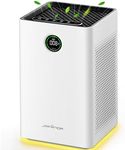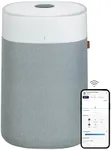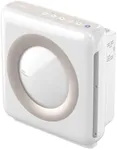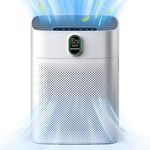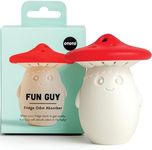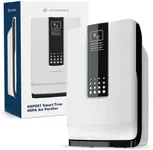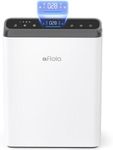Buying Guide for the Best Air Purifier For Large Rooms
Choosing an air purifier for a large room can make a big difference in your indoor air quality, especially if you have allergies, pets, or live in an area with pollution. The right air purifier will help remove dust, pollen, smoke, and other particles from the air, making your space healthier and more comfortable. To find the best fit, it's important to understand the key features and specifications that matter most for large spaces. By focusing on these, you can match your needs with the right product and enjoy cleaner air at home.Coverage Area (Square Feet or Square Meters)Coverage area tells you the maximum size of the room the air purifier can effectively clean, usually measured in square feet or square meters. This is important because using a purifier that's too small for your space means it won't clean the air efficiently. Coverage areas are often divided into small (up to 200 sq ft), medium (200-400 sq ft), and large (over 400 sq ft) rooms. For large rooms, look for purifiers rated for at least the size of your space, or a bit larger for better performance. Measure your room and choose a purifier that matches or exceeds that size.
Clean Air Delivery Rate (CADR)CADR stands for Clean Air Delivery Rate and measures how quickly the purifier can remove dust, pollen, and smoke from the air. Higher CADR numbers mean faster and more effective cleaning. CADR values are usually given for each type of particle, and for large rooms, you want higher numbers (often above 200 for each particle type). If you have specific concerns, like allergies or smoke, pay attention to the CADR for that particular particle. Choose a purifier with a CADR that matches the size of your room for the best results.
Filter TypeThe filter type determines what kinds of particles the air purifier can remove. The most common is a HEPA filter, which captures very small particles like dust, pollen, and pet dander. Some purifiers also have activated carbon filters for odors and gases, or pre-filters for larger particles. For large rooms, a true HEPA filter is usually best, and if you want to remove smells or chemicals, look for one with an additional carbon filter. Think about your main concerns—like allergies, pets, or smoke—and pick a filter type that targets those issues.
Air Changes Per Hour (ACH)ACH tells you how many times the air purifier can clean the entire volume of air in a room in one hour. A higher ACH means the air is cleaned more frequently, which is especially important in large rooms or if you have high air pollution. Typical values range from 2 to 5 ACH. For allergy sufferers or people with respiratory issues, aim for a higher ACH (4 or more). For general use, 2-3 ACH is usually enough. Match the ACH to your needs and the size of your room for the best air quality.
Noise LevelNoise level is how loud the air purifier is when running, usually measured in decibels (dB). This matters if you plan to use the purifier in a bedroom, living room, or office where quiet is important. Noise levels can range from very quiet (under 30 dB) to quite noticeable (over 60 dB). For large rooms, purifiers may be a bit louder due to bigger fans, but many have adjustable speeds. If you’re sensitive to noise, look for models with a quiet or sleep mode, and check the noise rating at different fan speeds.
Energy ConsumptionEnergy consumption tells you how much electricity the air purifier uses, which can affect your utility bills if you run it often. This is usually measured in watts. For large rooms, purifiers may use more power, but many are designed to be energy efficient. If you plan to run your purifier all day, look for models with an energy-saving mode or an Energy Star rating. Consider your usage habits and pick a purifier that balances performance with reasonable energy use.
Maintenance and Filter ReplacementMaintenance involves how often you need to clean or replace the filters, and how easy it is to do so. Some filters last longer than others, and replacement costs can add up over time. For large rooms, filters may need changing more often due to higher air volume. Check how often the manufacturer recommends replacing filters and how easy it is to access them. If you want low maintenance, look for purifiers with longer-lasting filters and clear filter change indicators.



